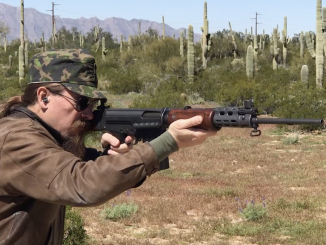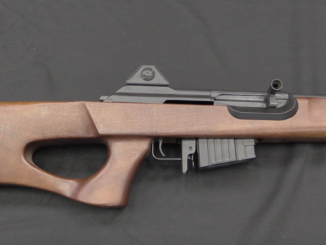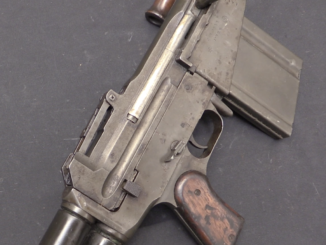When the Israeli Defense Forces tested the FN Minimi, they found it to be lacking in a few areas, and decided that they could develop a better SAW domestically. Developed in the 1980s, the result was the Negev. Like the Minimi, the Negev is a 5.56mm light machine gun that can feed from either belts or box magazines (Galil mags or AR mags with an adapter), has quick-changes barrels, and fires form an open bolt. The Negev has several features the Minimi does not, though, including a semiauto fire control position, optics mounting on the receiver (instead of the top cover), a standard folding stock, and some mechanical improvements internally.
So, let’s dig into this Negev and see how it ticks!
Many thanks to Movie Armaments Group in Toronto for the opportunity to showcase their Negev for you! Check them out on Instagram to see many of the guns in their extensive collection.




Wow, but there is a lot of welding on that receiver
Yes there is and parts are quite slender/thin so one could expect distortion. My guess would be use of top notch welding equipment.
Between 2005 and 2009 I was running a machine gun range for the 442nd Signal Battalion, Nevada Army National Guard. I was an experienced armorer and small arms trainer–though the M249 was adopted after I completed my unit armorer course. There was no belted ammunition and I was running four M249 Squad Automatic Weapons using M16 magazines (lime green followers)–I think I had 30 magazines. Something like 12,000 rounds permitted me to run around 200 shooters at 60 rounds per gun and I was expecting Malfunction Junction–so I serviced the guns with my assistant trainer (a combat vet who carried the M249 in Afghanistan) and made certain that the magazines were all clean and had good feed lips. I kept a notebook handy to record malfunctions and didn’t see any at the range running the guns two at a time. The shooters ranged from unfamiliar with machine guns to having qualified on the standard Army machine gun tables for the M249–I paired up experienced and inexperienced when possible. Oh, yeah–I over-lubed the guns and did a quick wipe-down between relays (4 magazines per relay).
I mention this because the M249’s reputation for jamming when feeding from M16 magazines may not be factual today. Both my assistant and I were astonished that we didn’t see any malfunctions–and we had to turn in the residue at the end of the range (links, spent brass, damaged or unexpended live cartridges, stripper clips, clip guides and dunnage from the ammo cans). It was a one-time summer event at the Fallon range under desert conditions.
Reliable machine guns are a must–it’s too much to ask a casual user to reduce bunches and oodles of stoppages.
Never forget the mag feed on the Minimi was more of a marketing gimmick. It was only intended for emergency use. When linked 5.56 was something new, being able of using mags made potential buyers more serene.
Ian correctly discuss the increased rate of fire but up he failed to mention that Minimi also have a adjustable gas regulator. Newer MK3 model dispense with the regulator by virtue of an hydraulic buffer.
As your experience, most use of mags in Minimi is in training when linked ammo is unavailable which seem to occur often for blanks.
So which is better, the Negev or Knight’s LAMG, and why?
They have one thing in common, both are and will be commercial failures.
Btw, the only obvious drawback I see with either of them is their short but still mostly traditional top covers. Although fine for use with red dots, it looks like the top cover will still prevent the use of many longer magnified scopes, like most 1-6x variables. Somewhere, I thought I saw a belt-fed prototype with a clever side-mounted loading cover, but now I can’t remember what gun that was.
“what gun that was”
I know machine gun with cover opening to side rather top, but it is production not prototype and tray-feed not belt-fed. Namely (famously unreliable) St. Étienne 1907, see 4th image from top: https://modernfirearms.net/en/machineguns/france-machineguns/st-etienne-m1907-eng/
Several of the early FG42-inspired prototypes leading to the M60 did as well, specifically the T44. https://upload.wikimedia.org/wikipedia/commons/d/de/T44.jpg
Don’t forget the Rheinmetall MG1960
This is an example of function before form/ appearance. No, the thing is not visually appealing, but everything used on it is done right. And on top of it is light so it can be fired off hand, standing, running or kneeling. The 7.62 version is a serious contender to PKM.
A general note on MGs feeding systems coming from my long term observations. We should understand from previous Ian’s lessons why M42 had that 2-stage feed – it was primarily needed to handle high rate of fire. For anything like 800 RPM and less is not needed. This opens door for simplification/ lower cost.
Also, one detail which may be overlooked at first glance. The belt has its weight and having feed pawls down directly in connection with top push-down ones under makes sense. That frees feed cover from unnecessary transfer mechanism. So this is winning approach, any way you look at it.
Oh, did I mention that optic does not have to be mounted on wobbly base…. Ian’ said that already.
“…with top push-down ones under makes sense” ought to be:
“with push-down ones under cover makes sense”
“(…)anything like 800 RPM and less is not needed(…)”
Keep in mind that as fire-arms have their Rate-of-Fire, magazines also have upper limit of Rate-to-Fire which they could support reliable. If you would build very high Rate-of-Fire machine gun accepting M16 magazines, they might fail to work reliable (deliver following cartridge fast enough).
I was especially impressed by the quick/easy barrel change procedure! That is a true life saver in combat conditions….Amen
Ian,
You said the Negev was a short-stroke gas action. I believe you spoke in error; like the AK/Galil/Lewis/FG42, it is a long-stroke action as the actual piston travels a much greater distance than the length than the cartridge case. Correct?
Yes, it certainly looks like piston head and bolt carrier are connected as can be seen in the disassembly, which is normal for a long stroke system.
can you please do a video on the differences that you mention between LMG operating like the mg42 and this? that would help people like me understand better.